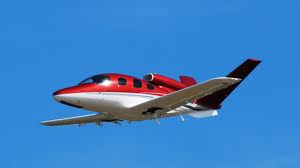 |
| Cirrus Aviation - SF 50 VLJ |
"Now we have been given the funding by our new owner CAIGA [China Aviation Industry General Aircraft], we plan to bring the aircraft to market within three years," says Cirrus vice-president and managing director of international sales, Ian Bentley, at the show in Friedrichshafen, Germany.
CAIGA bought the company, which is based in Duluth, Minnesota, last year, and has injected $100 million into the program, on top of the $45 million invested by its former owner. Bentley said the SF50 has been a key focus for Cirrus since its launch six years ago. Although the company was forced to slow development throughout the downturn due to a funding shortage, work on the seven-seat aircraft has continued, albeit at a low level. The non-conforming prototype has completed more than 600 flying hours and Cirrus has carried out "detail design, systems verification and full flight envelope testing since then", adds Bentley.
 |
| Diamond D-Jet |
"Our D-Jet will enter service a year earlier than the SF-50," says Diamond Aircraft chief executive Christian Dries. The programme - which is managed by Diamond's Canadian subsidiary - received a large chunk of investment last year from an undisclosed source.
Earlier in the same year the company suspended development of the five-seat aircraft after the Canadian government denied a $35 million loan that was to be matched by Ontario province. Dries says about $80 million is needed to bring the $1.9 million aircraft into serial production, but he says all the engineering issues and risks have been resolved. "If I had know seven years ago how difficult it would be to develop a single-engine jet, I wouldn't have done it," he concedes.
Meanwhile, Dries revealed a glimpse of Diamond's new unmanned medium twin-engine helicopter. Called Heros - Helicopter Robotic System - the 600kg (1,323lb) aircraft is targeted at the civilian and military airborne sensor and reconnaissance markets and is being developed in partnership with an unnamed company.
"Heros will fly autonomously with a degree of artificial intelligence and flight judgement," says Dries. "For example, in the event of an engine failure, the aircraft will be capable of analyzing and picking the best landing spot before entering an auto rotation approach and touchdown," he adds.
Heros is powered by two Austro AE55 engines - developed by Diamond's sister company - and is also fitted with a parachute. Diamond has received "a lot of global interest in the aircraft", which is poised to enter formal flight testing.
Flight Global
Differences Between D-Jet and SF-50
"Hello,
ReplyDeleteThis is really great information found here, I really like your blog. Thanks very much for the share. Keep posting."
PIC Bonus 2014